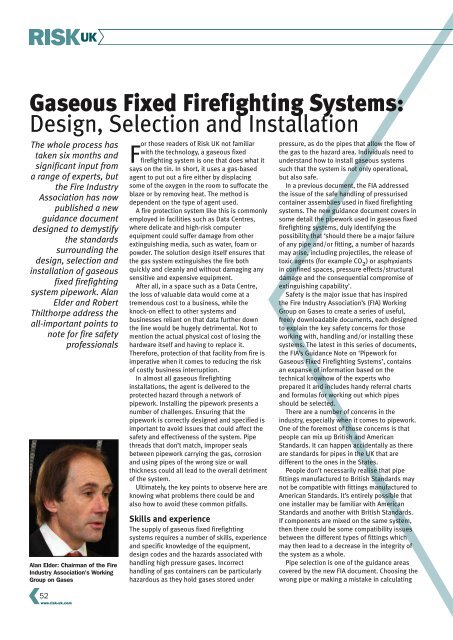RiskUKSeptember2017
Create successful ePaper yourself
Turn your PDF publications into a flip-book with our unique Google optimized e-Paper software.
Gaseous Fixed Firefighting Systems:<br />
Design, Selection and Installation<br />
The whole process has<br />
taken six months and<br />
significant input from<br />
a range of experts, but<br />
the Fire Industry<br />
Association has now<br />
published a new<br />
guidance document<br />
designed to demystify<br />
the standards<br />
surrounding the<br />
design, selection and<br />
installation of gaseous<br />
fixed firefighting<br />
system pipework. Alan<br />
Elder and Robert<br />
Thilthorpe address the<br />
all-important points to<br />
note for fire safety<br />
professionals<br />
Alan Elder: Chairman of the Fire<br />
Industry Association’s Working<br />
Group on Gases<br />
52<br />
www.risk-uk.com<br />
For those readers of Risk UK not familiar<br />
with the technology, a gaseous fixed<br />
firefighting system is one that does what it<br />
says on the tin. In short, it uses a gas-based<br />
agent to put out a fire either by displacing<br />
some of the oxygen in the room to suffocate the<br />
blaze or by removing heat. The method is<br />
dependent on the type of agent used.<br />
A fire protection system like this is commonly<br />
employed in facilities such as Data Centres,<br />
where delicate and high-risk computer<br />
equipment could suffer damage from other<br />
extinguishing media, such as water, foam or<br />
powder. The solution design itself ensures that<br />
the gas system extinguishes the fire both<br />
quickly and cleanly and without damaging any<br />
sensitive and expensive equipment.<br />
After all, in a space such as a Data Centre,<br />
the loss of valuable data would come at a<br />
tremendous cost to a business, while the<br />
knock-on effect to other systems and<br />
businesses reliant on that data further down<br />
the line would be hugely detrimental. Not to<br />
mention the actual physical cost of losing the<br />
hardware itself and having to replace it.<br />
Therefore, protection of that facility from fire is<br />
imperative when it comes to reducing the risk<br />
of costly business interruption.<br />
In almost all gaseous firefighting<br />
installations, the agent is delivered to the<br />
protected hazard through a network of<br />
pipework. Installing the pipework presents a<br />
number of challenges. Ensuring that the<br />
pipework is correctly designed and specified is<br />
important to avoid issues that could affect the<br />
safety and effectiveness of the system. Pipe<br />
threads that don’t match, improper seals<br />
between pipework carrying the gas, corrosion<br />
and using pipes of the wrong size or wall<br />
thickness could all lead to the overall detriment<br />
of the system.<br />
Ultimately, the key points to observe here are<br />
knowing what problems there could be and<br />
also how to avoid these common pitfalls.<br />
Skills and experience<br />
The supply of gaseous fixed firefighting<br />
systems requires a number of skills, experience<br />
and specific knowledge of the equipment,<br />
design codes and the hazards associated with<br />
handling high pressure gases. Incorrect<br />
handling of gas containers can be particularly<br />
hazardous as they hold gases stored under<br />
pressure, as do the pipes that allow the flow of<br />
the gas to the hazard area. Individuals need to<br />
understand how to install gaseous systems<br />
such that the system is not only operational,<br />
but also safe.<br />
In a previous document, the FIA addressed<br />
the issue of the safe handling of pressurised<br />
container assemblies used in fixed firefighting<br />
systems. The new guidance document covers in<br />
some detail the pipework used in gaseous fixed<br />
firefighting systems, duly identifying the<br />
possibility that ‘should there be a major failure<br />
of any pipe and/or fitting, a number of hazards<br />
may arise, including projectiles, the release of<br />
toxic agents (for example CO 2 ) or asphyxiants<br />
in confined spaces, pressure effects/structural<br />
damage and the consequential compromise of<br />
extinguishing capability’.<br />
Safety is the major issue that has inspired<br />
the Fire Industry Association’s (FIA) Working<br />
Group on Gases to create a series of useful,<br />
freely downloadable documents, each designed<br />
to explain the key safety concerns for those<br />
working with, handling and/or installing these<br />
systems. The latest in this series of documents,<br />
the FIA’s Guidance Note on ‘Pipework for<br />
Gaseous Fixed Firefighting Systems’, contains<br />
an expanse of information based on the<br />
technical knowhow of the experts who<br />
prepared it and includes handy referral charts<br />
and formulas for working out which pipes<br />
should be selected.<br />
There are a number of concerns in the<br />
industry, especially when it comes to pipework.<br />
One of the foremost of those concerns is that<br />
people can mix up British and American<br />
Standards. It can happen accidentally as there<br />
are standards for pipes in the UK that are<br />
different to the ones in the States.<br />
People don’t necessarily realise that pipe<br />
fittings manufactured to British Standards may<br />
not be compatible with fittings manufactured to<br />
American Standards. It’s entirely possible that<br />
one installer may be familiar with American<br />
Standards and another with British Standards.<br />
If components are mixed on the same system,<br />
then there could be some compatibility issues<br />
between the different types of fittings which<br />
may then lead to a decrease in the integrity of<br />
the system as a whole.<br />
Pipe selection is one of the guidance areas<br />
covered by the new FIA document. Choosing the<br />
wrong pipe or making a mistake in calculating

















